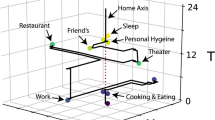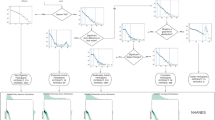Abstract
Patterns of human behavior over extended periods of time are important for characterizing human exposure to hazardous chemicals. Because longitudinal behavior patterns for an individual are difficult to obtain, exposure-assessors have characterized such patterns by linking daily records from multiple individuals. In an earlier publication, we developed an alternative strategy that was based on agent-based simulation modeling. Specifically, we created a software program, Agent-Based Model of Human Activity Patterns (ABMHAP), that generates year-long longitudinal behavior patterns. In this paper, we both calibrate and evaluate ABMHAP using human behavior data from the U.S. Environmental Protection Agency’s Consolidated Human Activity Database (CHAD). We use the longitudinal data (data on individuals' activities over multiple days) in CHAD to parameterize ABMHAP, and we use single-day behavior data from CHAD to evaluate ABMHAP predictions. We evaluate ABMHAP’s ability to simulate sleeping, eating, commuting, and working (or attending school) for four populations: working adults, nonworking adults, school-age children, and preschool children. The results demonstrate that ABMHAP, when parameterized with empirical data, can capture both interindividual and intraindividual variation in behaviors in different types of individuals. We propose that simulating annual activity patterns via ABMHAP may allow exposure-assessors to characterize exposure-related behavior in ways not possible with traditional survey methods.
This is a preview of subscription content, access via your institution
Access options
Subscribe to this journal
Receive 6 print issues and online access
$259.00 per year
only $43.17 per issue
Buy this article
- Purchase on Springer Link
- Instant access to full article PDF
Prices may be subject to local taxes which are calculated during checkout




Similar content being viewed by others
References
Klepeis NE. An introduction to the indirect exposure assessment approach: modeling human exposure using microenvironmental measurements and the recent national human activity pattern survey. Environ Health Perspect. 1999;107:365–74.
Zartarian V, Xue J, Glen G, Smith L, Tulve N, Tornero-Velez R. Quantifying children’s aggregate (dietary and residential) exposure and dose to permethrin: application and evaluation of EPA’s probabilistic SHEDS-multimedia model. J Expo Sci Environ Epidemiol. 2012;22:267–73.
Egeghy PP, Quackenboss JJ, Catlin S, Ryan PB. Determinants of temporal variability in NHEXAS-Maryland. J Expo Anal Environ Epidemiol. 2005;15:388–97.
Isaacs K, McCurdy T, Glen G, Nysewander M, Errickson A, Forbes S, et al. Statistical properties of longitudinal time-activity data for use in human exposure modeling. J Expo Sci Environ Epidemiol. 2013;23:328–36.
Glen G, Smith L, Isaacs K, McCurdy T, Langstaff J. A New method of longitudinal diary assembly for human exposure modeling. J Expo Sci Environ Epidemiol. 2008;18:299–311.
Graham SE, McCurdy T. Developing meaningful cohorts for human exposure models. J Expo Anal Environ Epidemiol. 2004;14:23–43.
Xue J, McCurdy T, Spengler J, Özkaynak H. UnderStanding Variability in Time Spent in Selected Locations for 7–12-year old children. J Expo Anal Environ Epidemiol. 2014;14:222–33.
Klepeis NE. Modeling human exposure to air pollution. In Ott WR, Steinemann AC, Wallace LA, editors. Exposure analysis. Boca Raton, Florida: CRC Press; 2006. p. 445–70.
Brandon N, Dionisio K, Isaacs K, Tornero-Velez R, Kapraun D, Setzer W, et al. Simulating exposure-related behaviors using agent-based models embedded with needs-based artificial intelligence. J Expo Sci Environl Epidemiol. 2018. https://doi.org/10.1038/s41370-018-0052-y.
Python Software Foundation. Python Software Foundation Website. https://www.python.org. Accessed 19 July 2017.
Zubek R. Needs-based AI. In: Lake J, editor. Game Programming Gems 8. Boston, MA: Course Technology; 2011. p. 302–11.
Moya J, Phillips L, Schuda L, Wood P, Diaz A, Lee R.U.S. EPA et al. Exposure factors handbook. 2011 Washington, DC: U.S. Environmental Protection Agency; 2011. P.
United States Environmental Protection Agency. Consolidated Human Activity Database (CHAD) for use in human exposure and health studies and predictive models. https://www.epa.gov/healthresearch/consolidated-human-activity-database-chad-use-human-exposure-and-health-studies-and. Accessed Jan 2018.
McCurdy T, Glen G, Smith L, Lakkadi Y. The national exposure research laboratory’s consolidated human activity database. Int J Expo Anal Environ Epidemiol.2000;10:566–78.
Isaacs KK, Glen WG, Egeghy P, Goldsmith MR, Smith L, Vallero D, et al. SHEDS-HT: an integrated probabilistic exposure model for prioritizing exposures to chemicals with near-field and dietary sources. Environ Sci Technol. 2014;48:12750–9.
Wu X, Bennett DH, Lee K, Cassady DL, Ritz B, Hertz-Picciotto I. longitudinal variability of time-location/activity patterns of population at different ages: a longitudinal study in california. Environ Health. 2011; 10. https://doi.org/10.1186/1476-069X-10-80.
Fitbit. Fitbit. https://www.fitbit.com. Accessed 18 Apr 2018.
Rider CV, Dourson ML, Hertzberg RC, Mumtaz MM, Price PS, Simmons JE. Incorporating nonchemical stressors into cumalative risk assessments. Toxicol Sci. 2012;127:10–7.
Price PS, Chaisson CF. A conceptual framework for modeling aggregate and cumalative exposure to chemicals. J Expo Sci Environ Epidemiol. 2005;15:473–81.
Hertz-Picciotto I, Cassady D, Lee K, Bennett DH, Ritz B, Vogt R. Study of use of products and exposure-related behaviors (SUPERB): study design, methods, and demographic characteristics of cohorts. Environ Health. 2010; 9. https://doi.org/10.1186/1476-069X-9-54.
Klepeis NE, Nelson WC, Ott WR, Robinson JP, Tsang AM, Switzer P, et al. The National Human Activity Pattern Survey (NHAPS): a resource for assessing exposure to environmental pollutants. J Expo Anal Environ Epidemiol. 2001;11:231–52.
Zartarian VG, Xue J, Ozkaynak H, Dang W, Glen G, Smith L, et al. A probabilistic arsenic exposure assessment for children who contact CCA-treated playsets and decks, Part 1: model methodology, variability results, and model evaluation. Risk Anal. 2006;26:515–31.
Acknowledgements
The views expressed in this article are those of the authors and do not necessarily represent the views or policies of the U.S. Environmental Protection Agency. Mention of trade names or commercial products does not constitute endorsement or recommendation for use.
Author information
Authors and Affiliations
Corresponding author
Ethics declarations
Conflict of interest
The authors declare that they have no conflict of interest.
Additional information
Publisher’s note: Springer Nature remains neutral with regard to jurisdictional claims in published maps and institutional affiliations.
Rights and permissions
About this article
Cite this article
Brandon, N., Price, P.S. Calibrating an agent-based model of longitudinal human activity patterns using the Consolidated Human Activity Database. J Expo Sci Environ Epidemiol 30, 194–204 (2020). https://doi.org/10.1038/s41370-019-0156-z
Received:
Revised:
Accepted:
Published:
Issue Date:
DOI: https://doi.org/10.1038/s41370-019-0156-z
This article is cited by
-
A qualitative characterization of meso-activity factors to estimate soil exposure for agricultural workers
Journal of Exposure Science & Environmental Epidemiology (2023)
-
Exposure forecasting – ExpoCast – for data-poor chemicals in commerce and the environment
Journal of Exposure Science & Environmental Epidemiology (2022)
-
Recognizing human behaviors from surveillance videos using the SSD algorithm
The Journal of Supercomputing (2021)



